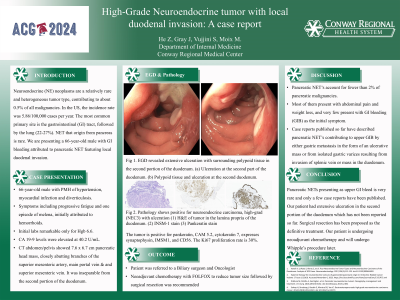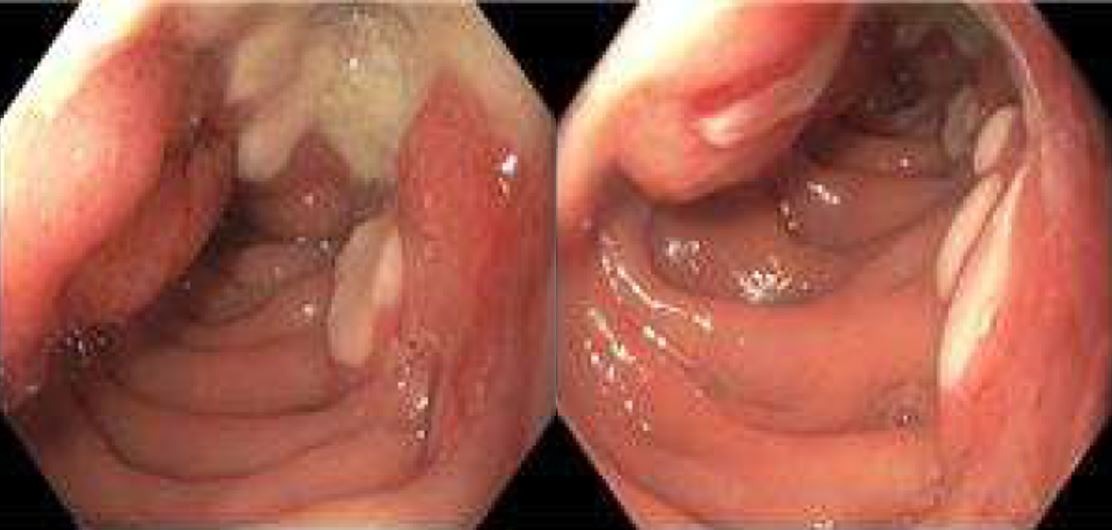Tuesday Poster Session
Category: Biliary/Pancreas
P3608 - High-Grade Neuroendocrine Tumor With Local Duodenal Invasion: A Case Report
Tuesday, October 29, 2024
10:30 AM - 4:00 PM ET
Location: Exhibit Hall E

Has Audio

Zhexiang He, DO
Conway Regional Health System
Conway, AR
Presenting Author(s)
Zhexiang He, DO, Sweehoney Vujjini, MD, Greg Kendrick, MD
Conway Regional Health System, Conway, AR
Introduction: Neuroendocrine neoplasms are a relatively rare and heterogeneous tumor type, contributing to about 0.5% of all malignancies. The most common primary site is the gastrointestinal tract, followed by the lung. Pancreatic neuroendocrine tumors (NETs) are rare, which contribute to 1-2% of pancreatic neoplasms. Pancreatic NETs can metastasize to nearby lymph nodes, the liver, and even other organs, although local duodenal invasion is extremely rare. We are presenting a 66-year-old male with gastrointestinal bleeding attributed to pancreatic neuroendocrine tumors featuring duodenal invasion.
Case Description/Methods: The patient is a 66-year-old male with a past medical history of hypertension, myocardial infarction, and diverticulosis presented to the emergency department due to progressing fatigue. He also reported one episode of dark stool. The patient denies nausea, vomiting, abdominal pain, diarrhea, or constipation. He reported daily aspirin and occasional ibuprofen use but not recently.
In the ED, his H&H was 6.6/22.0. BMP and LFTs were mostly within the normal range. CA 19-9 was 40.2 U/mL. A CT abd/pelvis revealed a 6.7 x 7.6 cm mass surrounding the pancreatic head. This mass closely abutted several branches of the surrounding blood vessels. It is also inseparable from the second portion of the duodenum.
An EGD was performed and revealed extensive ulceration with surrounding polypoid tissue in the second portion of the duodenum. Biopsy confirms high-grade neuroendocrine carcinoma (NEC3) with ulceration. The tumor displayed positive markers including pankeratin, CAM 5.2, cytokeratin 7, synaptophysin, IMSM1, and CD56. The Ki67 proliferation rate was 30%.
The patient was referred to a biliary surgeon and an oncologist. Both specialists recommended neoadjuvant chemotherapy followed by Whipper procedure, with the FOLFOX regimen chosen to reduce tumor size.
Discussion: NETs account for fewer than 2% of pancreatic malignancies. Most patients with NETs present with abdominal pain and weight loss, and very few present with GI bleeding (GIB) as the initial symptom. Case reports published so far have described Pancreatic NET’s contributing to upper GIB by either gastric metastasis in the form of an ulcerative mass or from isolated gastric varices resulting from invasion of splenic vein or mass in the duodenum. Our patient has extensive ulceration in the second portion of the duodenum which has not been reported so far. Surgical resection has been proposed as the definitive treatment.

Disclosures:
Zhexiang He, DO, Sweehoney Vujjini, MD, Greg Kendrick, MD. P3608 - High-Grade Neuroendocrine Tumor With Local Duodenal Invasion: A Case Report, ACG 2024 Annual Scientific Meeting Abstracts. Philadelphia, PA: American College of Gastroenterology.
Conway Regional Health System, Conway, AR
Introduction: Neuroendocrine neoplasms are a relatively rare and heterogeneous tumor type, contributing to about 0.5% of all malignancies. The most common primary site is the gastrointestinal tract, followed by the lung. Pancreatic neuroendocrine tumors (NETs) are rare, which contribute to 1-2% of pancreatic neoplasms. Pancreatic NETs can metastasize to nearby lymph nodes, the liver, and even other organs, although local duodenal invasion is extremely rare. We are presenting a 66-year-old male with gastrointestinal bleeding attributed to pancreatic neuroendocrine tumors featuring duodenal invasion.
Case Description/Methods: The patient is a 66-year-old male with a past medical history of hypertension, myocardial infarction, and diverticulosis presented to the emergency department due to progressing fatigue. He also reported one episode of dark stool. The patient denies nausea, vomiting, abdominal pain, diarrhea, or constipation. He reported daily aspirin and occasional ibuprofen use but not recently.
In the ED, his H&H was 6.6/22.0. BMP and LFTs were mostly within the normal range. CA 19-9 was 40.2 U/mL. A CT abd/pelvis revealed a 6.7 x 7.6 cm mass surrounding the pancreatic head. This mass closely abutted several branches of the surrounding blood vessels. It is also inseparable from the second portion of the duodenum.
An EGD was performed and revealed extensive ulceration with surrounding polypoid tissue in the second portion of the duodenum. Biopsy confirms high-grade neuroendocrine carcinoma (NEC3) with ulceration. The tumor displayed positive markers including pankeratin, CAM 5.2, cytokeratin 7, synaptophysin, IMSM1, and CD56. The Ki67 proliferation rate was 30%.
The patient was referred to a biliary surgeon and an oncologist. Both specialists recommended neoadjuvant chemotherapy followed by Whipper procedure, with the FOLFOX regimen chosen to reduce tumor size.
Discussion: NETs account for fewer than 2% of pancreatic malignancies. Most patients with NETs present with abdominal pain and weight loss, and very few present with GI bleeding (GIB) as the initial symptom. Case reports published so far have described Pancreatic NET’s contributing to upper GIB by either gastric metastasis in the form of an ulcerative mass or from isolated gastric varices resulting from invasion of splenic vein or mass in the duodenum. Our patient has extensive ulceration in the second portion of the duodenum which has not been reported so far. Surgical resection has been proposed as the definitive treatment.

Figure: EGD revealed extensive ulceration with surrounding polypoid tissue in the second portion of the duodenum
Disclosures:
Zhexiang He indicated no relevant financial relationships.
Sweehoney Vujjini indicated no relevant financial relationships.
Greg Kendrick indicated no relevant financial relationships.
Zhexiang He, DO, Sweehoney Vujjini, MD, Greg Kendrick, MD. P3608 - High-Grade Neuroendocrine Tumor With Local Duodenal Invasion: A Case Report, ACG 2024 Annual Scientific Meeting Abstracts. Philadelphia, PA: American College of Gastroenterology.
